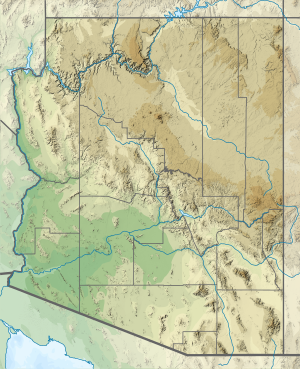
Back Cabeza Prieta National Wildlife Refuge CEB Cabeza Prieta National Wildlife Refuge German Cabeza Prieta National Wildlife Refuge French
| Cabeza Prieta National Wildlife Refuge | |
|---|---|
IUCN category IV (habitat/species management area) | |
 El Camino Del Diablo at the eastern entrance to CPNWR, 2014 | |
| Location | Yuma County / Pima County, Arizona, United States |
| Nearest city | Yuma, Arizona |
| Coordinates | 32°19′N 113°26′W / 32.317°N 113.433°W |
| Area | 860,010 acres (3,480.3 km2)[1] |
| Established | 1939 |
| Governing body | United States Fish and Wildlife Service |
| Website | Cabeza Prieta National Wildlife Refuge |
Cabeza Prieta National Wildlife Refuge (CPNWR) is located in southwestern Arizona in the United States, along 56 miles (90 km) of the Mexico–United States border. It is bordered to the north and to the west by the Barry M. Goldwater Air Force Range, to the south by Mexico's El Pinacate y Gran Desierto de Altar Biosphere Reserve, to the northeast by the town of Ajo, and to the southeast by Organ Pipe Cactus National Monument.
Located within the Yuma Desert, a lower-elevation section of the Sonoran Desert, the refuge was originally established in 1939 to protect desert bighorn sheep.[2] It is home to more than 275 different species of animals and nearly 400 species of plants.[3]
CPNWR is the third largest national wildlife refuge in the lower 48 states. Its total area is 860,010 acres (3,480 km2),[1] which is greater than that of the state of Rhode Island. The refuge is administered from a small headquarters building, located in Ajo.
The area is an active corridor for illegal entry and smuggling into the U.S.[4] Since 2017 the skeletal remains of at least forty people have been found here, migrants crossing who died due to lack of water and/or from extreme temperatures. The Trump administration tightened rules against leaving food, water and clothing in such areas even if meant to save lives. Humanitarian aid volunteers were convicted of a misdemeanor in 2019 for doing so, and the incident touched off a debate about moral authority.[5][6] Its wildlife is threatened by the militarization of the Mexico–United States border and the construction of the Mexico–United States border wall.[7]
- ^ a b Cite error: The named reference
CBD2011was invoked but never defined (see the help page). - ^ Cite error: The named reference
CPNWRARwas invoked but never defined (see the help page). - ^ Cite error: The named reference
CPNWRWHwas invoked but never defined (see the help page). - ^ Brean, Henry (August 15, 2019). "Trump administration delays border wall work in Arizona preserves". Arizona Daily Star. Retrieved August 15, 2019.
- ^ Gershman, Jacob (December 6, 2018). "Aid for Immigrants on Desert Trek Stirs Religion-Freedom Fight". Retrieved May 13, 2019 – via www.wsj.com.
- ^ "Guilty Verdict in first #Cabeza9 case". January 18, 2019. Retrieved May 13, 2019.
- ^ "What a Border Wall Could Mean for Wildlife | Audubon". www.audubon.org. Retrieved December 3, 2023.
© MMXXIII Rich X Search. We shall prevail. All rights reserved. Rich X Search

